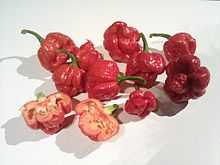Trinidad moruga scorpion
 | |
| Heat |
|
|---|---|
| Scoville scale | 1,200,000 on average, but can reach up to 2,000,000 |
The Trinidad moruga scorpion (Capsicum chinense) is native to the district of Moruga in Trinidad and Tobago. On February 13, 2012, New Mexico State University's Chile Pepper Institute identified the Trinidad moruga scorpion as the hottest chili in the world (later beat by the Carolina Reaper in 2015), with a mean heat of more than 1.2 million Scoville heat units (SHUs) and individual plants with a heat of more than 2 million SHUs.[1] The previous record holder was the bhut jolokia of India. The current world record holder is the Carolina Reaper.
Overview

Paul Bosland, a chili pepper expert and director of the Chile Pepper Institute, said, "You take a bite. It doesn't seem so bad, and then it builds and it builds and it builds. So it is quite nasty."[2]
Aside from the heat, the Trinidad moruga scorpion has a tender fruit-like flavor, which makes it a sweet-hot combination.[3] The pepper can be grown from seeds in most parts of the world. In North America, the growing season varies regionally from the last spring hard frost to the first fall hard frost. Freezing weather ends the growing season and kills the plant, but otherwise they are perennials which grow all year, slowing in colder weather.
On August 07, 2013, the Guinness World Records rated the 'Carolina Reaper' the world's hottest pepper, dethroning the ghost pepper and moruga scorpion.[4]
See also
References
- ↑ Justin Bannister (2012-02-13). "NMSU’s Chile Pepper Institute names the Trinidad Moruga Scorpion hottest pepper on earth". Retrieved 2013-11-26.
- ↑ Susan Montoya Bryan (February 15, 2012). "Chile experts: Trinidad Moruga Scorpion is hottest". Associated Press. Retrieved November 26, 2013.
- ↑ Joshi, Monika (2012-03-11). "Chile Pepper Institute studies what's hot". Your life. USA Today. Archived from the original on 2012-03-12.
- ↑ "Hottest Chili Pepper". Guinness World Records. Retrieved 26 December 2013.
| ||||||||||||||||||||||||||